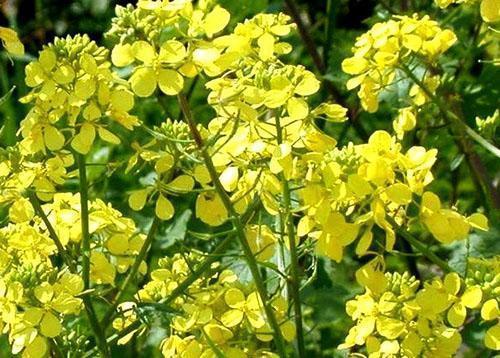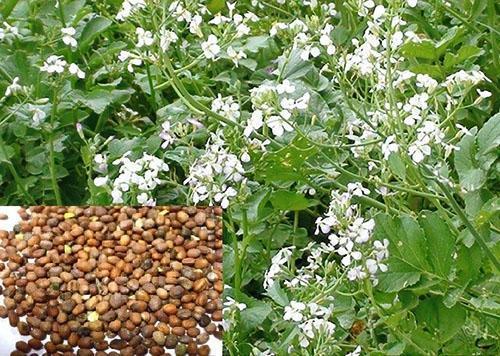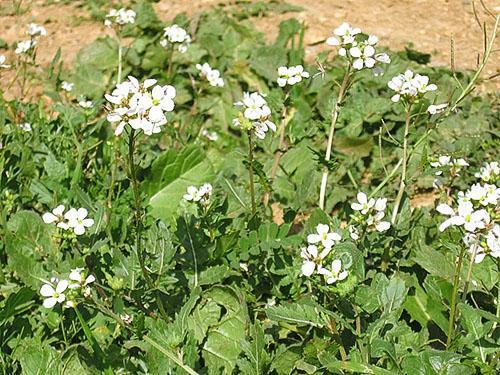Oil radish: green manure, forage, honey plant
 Oilseed radish is an annual fodder and melliferous crop. Belongs to the cruciferous family. It is widely used as green manure - green fertilizer. The seeds of the plant contain up to 50% vegetable oil. It is used in cooking, food processing, pharmacology, cosmetology, as well as for the production of biofuels.
Oilseed radish is an annual fodder and melliferous crop. Belongs to the cruciferous family. It is widely used as green manure - green fertilizer. The seeds of the plant contain up to 50% vegetable oil. It is used in cooking, food processing, pharmacology, cosmetology, as well as for the production of biofuels.

Oil radish as green manure
 Using oil radish as siderata in recent years, it has acquired strategic importance due to large-scale soil depletion.
Using oil radish as siderata in recent years, it has acquired strategic importance due to large-scale soil depletion.
Soil protection and enrichment
The oil radish has a strong root system. The long root allows nutrients to rise from the lower soil layers to the surface. By decaying, the mown green mass is transformed into a fertilizer rich in humus and organic matter.
Pancake radish is one of the most effective crops used to protect soil from erosion in spring and autumn, and if the plants are not harvested for the winter, they trap snow, contributing to the accumulation of moisture in the soil and less freezing.
The culture has a good effect on the structure of the soil, loosening it and providing drainage even in deep layers. As a result, the moisture and air permeability of the soil increases.
From the remnants of roots, the soil is enriched with mineral elements. On average, 1 hectare of area includes:
- nitrogen - 85 kg;
- phosphorus - 25 kg;
- potassium - 100 kg.
Phytosanitary qualities
The content of essential oils in the plant helps to resist pests and fungal diseases. Oil radish is used for preventive control of wireworm potato scab, rhizoctaniasis, nematodes. Dense foliage shades the soil well and suppresses weed growth. Oil radish is the main crop used in the control of stubborn weeds such as wheatgrass. Rotten tops serve as an excellent breeding ground for worms and other biological organisms that have a beneficial effect on the soil.
Oil radish should not be used as a green manure as a precursor to cabbage.
Oil radish as a forage crop
 As a fodder crop, oilseed radish is valued for its early maturity and consistently high yields. The average harvest is 300-400 c / ha, and when fertilizing, you can achieve 700 c / ha. The period from sowing to formation is only 40-50 days. Up to 3 mows can be performed per season. The green mass is fed to livestock fresh, silage, haylage, briquettes, grass flour are also prepared from it. Oil radish is ensiled, as a rule, with other annual grasses, and is added to the composition of vetch-oat and pea-oat mixtures. A 3-4 leaf stage crop is a good addition to corn.
As a fodder crop, oilseed radish is valued for its early maturity and consistently high yields. The average harvest is 300-400 c / ha, and when fertilizing, you can achieve 700 c / ha. The period from sowing to formation is only 40-50 days. Up to 3 mows can be performed per season. The green mass is fed to livestock fresh, silage, haylage, briquettes, grass flour are also prepared from it. Oil radish is ensiled, as a rule, with other annual grasses, and is added to the composition of vetch-oat and pea-oat mixtures. A 3-4 leaf stage crop is a good addition to corn.
It is advisable to grow oil radish as a forage crop in a mixture with sunflower, legumes and cereals.
 The cultivation of oil radish makes it possible to walk the animals in the pasture in late autumn. Plant vegetation continues even at a temperature of + 5-6 ° C. Oil radish does not die in frosts down to -4 ° C, and mature plants are able to withstand temperatures as low as -7 ° C.
The cultivation of oil radish makes it possible to walk the animals in the pasture in late autumn. Plant vegetation continues even at a temperature of + 5-6 ° C. Oil radish does not die in frosts down to -4 ° C, and mature plants are able to withstand temperatures as low as -7 ° C.
In terms of nutritional value, oil radish has qualities similar to compound feed, alfalfa, sainfoin and clover. It has a high protein content - up to 26%. For comparison: for corn, this indicator is at the level of 7-9%. At the same time, the protein is well balanced in amino acids. The culture is rich in phosphorus, potassium, calcium, magnesium, zinc, iron. During the flowering period, a kilogram of tops contains 30 mg of carotene and 600 mg of ascorbic acid.
Oil radish as honey plant
 Oil radish is a recognized melliferous crop. Its main advantages are long flowering (up to 30 days) and nectar secretion in cool weather. Honey harvesting occurs in early spring and mid-summer, when other melliferous crops have already faded. The content of sucrose, fructose and glucose in the nectar is 20%. Honey has a strong aroma and high medicinal properties.
Oil radish is a recognized melliferous crop. Its main advantages are long flowering (up to 30 days) and nectar secretion in cool weather. Honey harvesting occurs in early spring and mid-summer, when other melliferous crops have already faded. The content of sucrose, fructose and glucose in the nectar is 20%. Honey has a strong aroma and high medicinal properties.
Due to the rapid crystallization, it is not recommended to leave rare honey in combs for the winter.
 Bees prefer to visit the sparse field in the morning hours and cloudy weather. In the morning the flowers bloom at 6-7 am.
Bees prefer to visit the sparse field in the morning hours and cloudy weather. In the morning the flowers bloom at 6-7 am.
Growing oilseed radish
 The answer to the question “when to plant oil radish” depends on the goals set. Sowing of seeds is possible from April to mid-September. Plants planted in April give the highest yield. For feed and as a green manure, radish is sown in rows every 15 cm.Seed consumption is 2-3 g / m2... Sowing depth - 2-4 cm.
The answer to the question “when to plant oil radish” depends on the goals set. Sowing of seeds is possible from April to mid-September. Plants planted in April give the highest yield. For feed and as a green manure, radish is sown in rows every 15 cm.Seed consumption is 2-3 g / m2... Sowing depth - 2-4 cm.
Late sowing requires more seed consumption. When sowing after August 10, the rate is doubled, since in autumn the growth of plants slows down significantly. Late sowing is poorly suited for green manure.
When sowing mixed with spring vetch, the ratio of radish and vetch seeds is 1: 6. With this scheme, the stems of the radish act as supports for the climbing plant.
For honey collection and for seeds, oil radish is sown with row spacing of 40 cm.
The first shoots appear after 4 days, and after 40-50 days you can make the first mowing for forage. Flowering occurs about 40 days after germination.
When greening for winter crops, the radish is cut 3 weeks before sowing.
For rotting and the formation of humus from the green mass, it is necessary that the soil is moist.
When preparing the soil for spring sowing, the radish is left until frost.
 Seeds are collected in late autumn. The pods retain their shape and the seeds dry out naturally, which saves the cost of artificial drying.
Seeds are collected in late autumn. The pods retain their shape and the seeds dry out naturally, which saves the cost of artificial drying.
In Russia, you can buy oilseed radish seeds of popular varieties: Sabina, Nika, Jumping, Brutus, Raduga, Tambovchanka.
Oil radish is a wonderful green manure. At the dacha, potatoes usually grow in one place for years. The soil is depleted, although it receives regular fertilizing. I have divided this potato field in two. On one of them, after early potatoes, at the end of July, she sowed oil radish. The grass was beautiful, my field even bloomed, and in September the bees were still flying, collecting honey. She did not remove the grass, she left it to trap the snow. On our slope it blows away. The next year, I planted potatoes at this place for winter storage. There was no wireworm in the earth at all. The land is fluffy, the harvest is excellent. By the fall, no stems from the radish were found. Over the summer, the soil has reworked everything. The next year I also improved the second part of the field. The result is the same. I recommend to everyone.